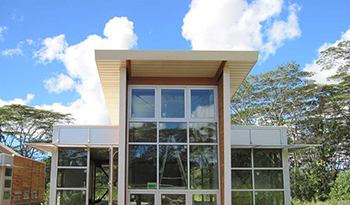University Energy Research Measures Climate, New Technology
 HONOLULU — The Hawaii Natural Energy Institute (HNEI), a research unit of the University of Hawai’i Manoa, recently installed six solar photovoltaic arrays as a part of its ongoing energy-efficiency and solar research. This investment will help scientists better understand photovoltaic performance in a variety of environmental conditions, according to HNEI.
HONOLULU — The Hawaii Natural Energy Institute (HNEI), a research unit of the University of Hawai’i Manoa, recently installed six solar photovoltaic arrays as a part of its ongoing energy-efficiency and solar research. This investment will help scientists better understand photovoltaic performance in a variety of environmental conditions, according to HNEI.
To help facilitate this initiative, the university has partnered with Project Frog Inc. The San Francisco-based smart design firm created three net-zero energy buildings as platforms for the school’s photovoltaic program. At just 1,200 square feet each, these state-of-the-art experimental buildings pack impressive potential in a modest design. They include multiple high-tech instruments that provide performance data on the building’s various design and material components. Additionally, temperature, humidity, CO2 levels, lighting and air conditioning are also measured.
Research at these facilities will also concentrate on the effectiveness and efficiency of photovoltaic inverters, which convert direct current (DC) power to alternating current (AC). The sites are primarily testing a single string inverter, which converts energy from multiple panels, against a one per panel micro-inverter system. Each is fitted with a system that allows for remote data collection and detailed analysis. Researchers are also testing and evaluating three different photovoltaic materials.
“These installations are part of a larger HNEI research endeavor to evaluate and compare the performance of traditional and emerging PV materials and inverter technologies,” said Dr. Richard Rocheleau, HNEI director. In addition to informing future research, Dr. Rocheleau adds that potential storage, efficiency and renewable generation findings could also have Naval applications.
According to Nikki Tankursley, director of marketing for Project Frog Inc., the firm was enthusiastic about the HNEI partnership. “We are excited to play such an integral role in HNEI’s research and together advance the science and technology behind new construction throughout the Islands,” Tankursley said. She adds that the local environment was an ideal fit for the structures, as Project Frog component buildings are very responsive to the Hawaiian climate.
Placing these structures and systems at local schools has added yet another element to the ongoing energy research. One Project Frog-designed building has been constructed at Ilima Intermediate Schools on the island of Oahu, while Kauai’s Kawaikini New Century Public Charter Schools is currently home to two. According to the university, these sites were chosen for their slight differences in climate, as small differences in microclimate may have a significant impact on the building performance. Additionally, students at these schools will now have the unique opportunity to learn in research platforms that double as classrooms.
Funding for this innovative partnership is provided through a grant to the university supported by the Office of Naval Research. Additional project partners include the State of Hawaii Department of Education and architecture and design firm MK Think of San Francisco. Risource Energy of Honolulu installed all three photovoltaic systems.
